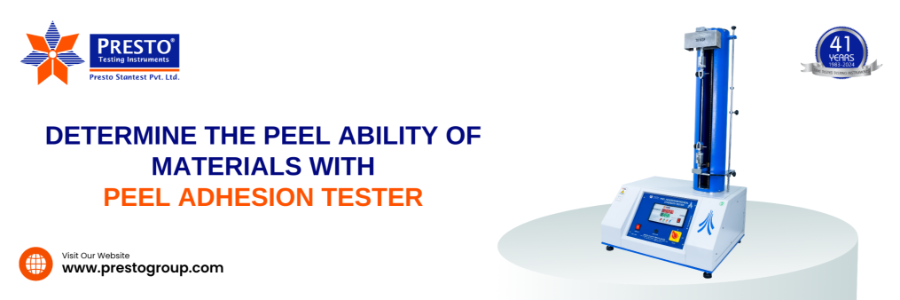

Gaurav Malhotra
03-2-2024
In various industries, the extensive use of adhesive materials demands a high standard of quality, particularly in terms of sealing effectiveness and durability. Ensuring the reliability of adhesive materials for industrial purposes involves conducting a Peel Strength Test, a crucial step in assessing their quality. For this purpose, one can place trust in reputable brands like the Peel Strength Tester offered by Presto Group.
This peel test equipment is designed to quantify the force needed to peel an adhesive coating or material from its surface. With its advanced features, the Peel Strength Tester provides exceptionally precise test results, enabling users to categorize materials based on their quality standards.
In this blog, we will discuss brief information about how you can easily determine the peeling ability of materials with the help of a Presto Peel Strength Tester.
The peel strength test is a widely employed practice in various industries to ensure the quality control of adhesives. However, manufacturers often overlook the importance of the quality and standardization of the testing equipment itself during the testing process.
It is crucial that the chosen instrument not only adheres to global test standards but also provides accurate test data. Presto offers a high-quality solution with its Digital Peel Adhesion Tester, equipped with flexible peel test facilities.
This highly standardized laboratory testing equipment has been designed specifically for conducting precise peel strength tests on adhesive materials. Different samples like glues, adhesives and tapes on packaging materials and surfaces can easily be tested using this high-quality peel-testing instrument.
This equipment has been meticulously designed and manufactured in accordance with industrial standards including standard ASTM D 903, ensuring reliability and accuracy in test results.
The Presto peel test equipment is customizable to meet your industry specifications through its inbuilt calibration technology, enabling users to adjust equipment performance according to their requirements. It features user-friendly soft feather-touch buttons for enhanced comfort.
During the peel strength test for adhesives, the equipment precisely assesses the peeling force needed to separate the adhesive from the substrate. A higher peel force indicates a stronger adhesive.
The equipment is equipped with a 20 Kgf load cell capacity, a digital screen for test display, and ensures an accuracy of ±2% on full load application. It maintains a test speed of 300 mm/min and incorporates safety switches for controlled testing. Additionally, a multi-speed feature is available with a VFD drive, allowing speeds ranging from 30 to 300 mm/min.
The display screen of this advanced equipment operates on a sophisticated microprocessor program, precisely converting applied force into numeric values. Users can conveniently view the calculated peel adhesive strength value on the screen. The uniform control of force application ensures an even distribution over the test specimen.
This versatile equipment offers dual-mode testing capabilities, allowing for peel tests at both 180 and 90-degree angles. Distinct sample clamping fixtures are provided for each test process, with the 90-degree fixture available upon request. To enhance visibility in low-light conditions, the display screen features bright LED installations for a clearer vision of the results.
Peel Strength encompasses three distinct factors: peel adhesion, shear resistance, and tensile strength. Industry standards dictate that this strength is assessed across the width of the tape, leading to a decrease in adhesion resistance against separating force.
The strength levels vary based on the application. For temporary sealing, balanced peel strength is preferred – not excessively high to hinder tape removal, yet not too low to compromise seal integrity. Conversely, in permanent sealing, the resistance against force should be maximized to ensure enduring strength.
If you want to buy a peel strength tester from Presto Group then you must consult with our technical team of experts.
We all know that adhesives play a crucial role in packing products more effectively. They not only safeguard the integrity of products but also ensure that the components of the materials will not get dismantled during shipping and handling. Therefore, conducting Peel Strength test on adhesives becomes a vital aspect of the quality control process. To perform a peel strength test, follow these steps:
1. Prepare the testing specimen before starting the machine.
2. Position the specimen between the upper and lower grips, tightening the grip securely.
3. Move the lower grip upwards to allow the specimen to reach the grips easily.
4. Ensure the lower limit switch ring is positioned with a minimum distance of 25mm.
5. Place the lower end of the specimen in the lower grips and tighten them securely, ensuring the specimen is centred.
6. Once these steps are accurately followed, commence the peel strength test.
Following this procedure, manufacturers in the packaging industry can conduct peel strength tests on materials. Users can perform T-peel, 90-degree peel, and 180-degree peel tests, ensuring the delivery of accurate products to customers. Presto Stantest Pvt Ltd, a leading manufacturer of peel strength testers offers a high-quality lab testing instrument at the best price.
The peel strength of the material can be affected and influenced by different factors that we have listed below.
These are some factors that you must take care of while conducting the peel strength test on the material. If you wish to know more about this testing equipment like peel tester price, features or technical specifications then you can give us a call at +919210903903 or email us at info@prestogroup.com. Our team of technical experts will help you solve all your needs and queries.
Related Blogs

Salt spray test checks corrosion resistance of materials using a salt spray chamber. Essential for quality control in coatings, metals, and finishes.

Hot Air Oven uses dry heat for sterilizing glassware and metal tools, while an Autoclave uses steam under pressure—ideal for liquids and medical items.

GSM of fabric (Grams per Square Meter) indicates fabric weight and thickness. Higher GSM means denser, heavier fabric; lower GSM means lighter, thinner fabric.